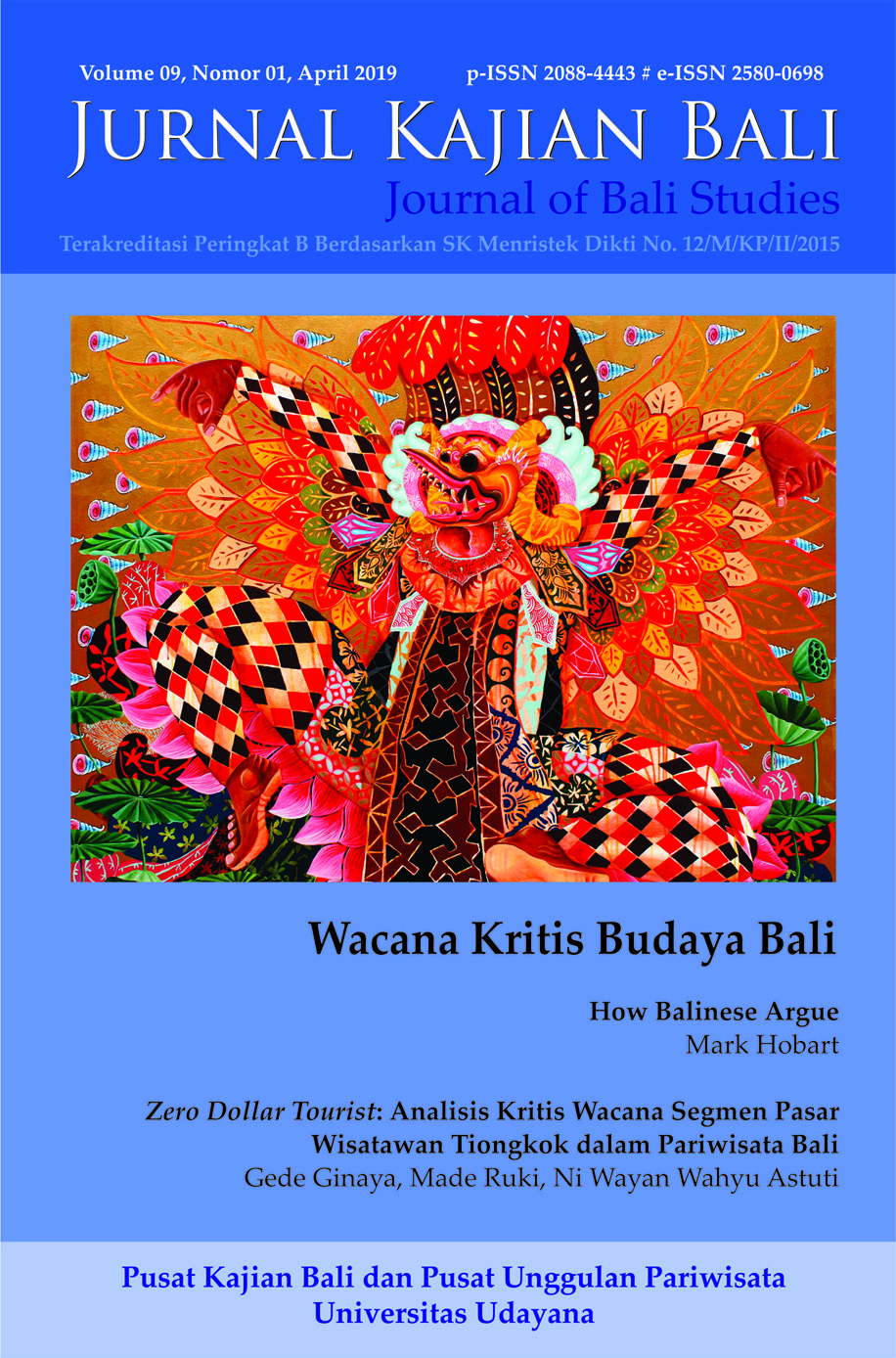How Balinese Argue
Abstract
The Imaginary of Bali as paradise stands in stark contrast to what is actually going on. To understand the split requires examining who is authorized to represent Bali as what under what conditions. The issue concerns the nature of argument – whether argumentation and disagreement – and how it disarticulates and marginalize alternatives. The preferred, hegemonic style of argument in Bali is monologue, favoured by those in power, which effectively anticipates and prevents contradiction. By contrast, dialogue is open, democratic and widespread in daily life, but often passes relatively unnoticed. Whereas dialogue enables discussion and problem-solving, monologue re-asserts ideology in the face of uncomfortable actualities. In Bali, the form ideology takes centres on fantasies about an imaginary ‘age-old culture’. The drawbacks are evident in how claims over the cultural antiquity of Tri Hita Karana disguise its grave shortcomings in practice.
Downloads
References
Aristotle, 2007. On rhetoric: a theory of civic discourse, with Introduction by G.A. Kennedy, Oxford: Univ. Press.
Astawa, I.G, Budiarsa, M., Simpen, I.W. 2018. Power and ideology revealed in the awig-awig (customary law) text of Tenganan Pagringsingan village: critical ecolinguistic study. International journal of linguistics 10, 5: 45-60).
Bakhtin, M.M. 1979. Iskusstvo i Otvetstvennost. (Art and responsibility) trans. G. S. Morson & C. Emerson in Morson & Emerson, Mikhael Bakhtin: creation of a prosaics, Stanford, CA: Univ. of Stanford Press.
________ 1981a. Epic and novel: towards a methodology for the study of the novel. In The dialogic imagination: four essays. Austin: Univ. of Texas Press.
________ 1981b. Discourse in the novel. In The dialogic imagination: four essays. Austin: Univ. of Texas Press.
________ 1984. Problems of Dostoevsky’s poetics. Minneapolis: Univ. of Minnesota Press.
________ 1986. The problem of the text in linguistics, philology, and the human sciences. in Speech genres and other late essays. Austin: Univ. of Texas Press.
Bernstein, B. 1971. Class, codes and control: theoretical studies towards a sociology of language. London: Routledge & Kegan Paul.
Bloch, M. 1974. Symbols, song, dance and features of articulation: is religion an extreme form of traditional authority? European archives of sociology 15: 55-81.
De Certeau, M. 1984. The practice of everyday life. London: Univ. of California Press.
Deleuze, G. & Guattari, F. 1988. A thousand plateaus: capitalism and schizophrenia. London: Athlone.
Foucault, M. 1981. The order of discourse, in Untying the text: a post-structuralist reader. ed. R. Young, London: Routledge & Kegan Paul.
Fox, R. 2011. Critical reflections on religion and media in contemporary Bali. Leiden: Brill.
________ 2017. Of family, futures and fear in a Balinese ward: some preliminary thoughts toward a new project. Jurnal kajian Bali 7, 1: 213-248.
Frazer, J.G. 1922 [1890]. The golden bough: a study in magic and religion. New York: Macmillan.
Hall, S. 1980. Encoding/decoding, in Culture, media, language: working papers in cultural studies, 1972-79. eds. S.
Hall et al. London: Unwin Hyman.
Hallpike, C. 1979. The foundations of primitive thought. Oxford: Clarendon Press.
Heryanto, A. 1999. Where communism never dies: violence, trauma and narration in the last cold war capitalist authoritarian state. International journal of cultural studies 2, 2: 147-177.
Hobart, M. 1985. Anthropos through the looking-glass: or how to teach the Balinese to bark. In Reason and morality. ed. J. Overing, London: Tavistock.
________ 2000. After culture. anthropology as radical metaphysical critique. Yogyakarta: Duta Wacana Press. Available at http://www.criticalia.org/bibliography---mark-hobart/after-culture-complete.pdf
________ 2007. Rethinking Balinese dance, in M. Cohen et al., Indonesian performing arts in a transnational context, special issue of Indonesia and the Malay World, 35: 107-28.
________ 2015. Beyond Words Some thoughts about how Balinese argue. Available at: http://www.criticalia.org/symposia--panels/hobart---beyond-words.pdf.
________ 2016. Talking to God: on argument, agency and articulation in Bali. Available at: http://www.criticalia.org/symposia--panels/hobart---talking-to-god.pdf.
________ 2017. Bali is a battlefield, or the triumph of the imaginary over actuality. Jurnal kajian Bali 7, 1: 167-92.
Hobsbawm, E.J. & Ranger, T. eds. 1983. The invention of tradition. Cambridge: Univ. Press.
Hollis, M. and Lukes, S. eds. 1982. Rationality and relativism. Oxford: Blackwell.
Hooykaas, C. 1966. Sūrya-Sevana: the way to God of a Balinese Siva Priest. Amsterdam: Noord Hollandsche Uitgevers Maatschappij.
Kennedy, G.A. 1998. Comparative rhetoric: an historical and cross-cultural introduction. Oxford: Univ. Press.
________ 2007. Introduction to Aristotle on rhetoric: a theory of civic discourse. Oxford: Univ. Press.
Laclau, E. 1990. The impossibility of society. In New reflections on the revolution of our time. London: Verso.
Laclau, E. & Mouffe, C. 1985. Hegemony and socialist strategy: towards a radical democratic politics. London: Verso.
Lefebvre, H. 2005. The critique of everyday life: from modernity to modernism (towards a metaphilosophy of daily life). London: Verso.
Lévy-Bruhl, L. 1910. Les fonctions mentales dans les sociétés inférieurs. Paris: Alcan; translated as How natives think.
MacRae, G. 2017. Universal heritage meets local livelihoods: ‘awkward engagements’ at the world cultural heritage listing in Bali. International journal of heritage studies 23, 9: 846-859.
McLuhan, M. 1964. The medium is the message. In Understanding media: the extensions of man. London: Routledge.
Moerdowo, R.M. 1977. Reflections on Balinese traditional and modern arts. Denpasar: Udayana University.
Nietzsche, F. 1989a. Description of ancient rhetoric 1872-73, in Friedrich Nietzsche on rhetoric and language, eds. Gilman, S. et al. New York, NY: Oxford Univ. Press.
Nietzsche, F. 1989b. On truth and lying, in Friedrich Nietzsche on rhetoric and language, eds. Gilman, S. et al. New York, NY: Oxford Univ. Press.
Overing, J. ed. 1985. Reason and morality. London: Tavistock.
Picard, M. 1996. Bali: cultural tourism and touristic culture. Singapore: Archipelago Press.
________ 2011. Balinese religion in search of recognition; from Agama Hindu Bali to Agama Hindu (1945-65). Bijdragen tot de taal-, land- en volkenkunde 167, 4.
________ 2015. The polemics between Surya Kanta (1925-1927) and Bali Adnjana (1924-1930): how Balinese argue (in Malay). http://www.criticalia.org/symposia--panels/picard---the-polemics-betwe.pdf.
Potter, K.H. 1977. Indian metaphysics and epistemology: the tradition of Nyāya-Vaiśeṣika up to Gangesa. Princeton, N.J.: Univ. Press.
Roth, D. & Sedana. G. 2015. Reframing Tri Hita Karana: from ‘Balinese culture’ to politics. The Asia Pacific journal of anthropology 16:2: 157-175.
Scott, J.C. 1985. Weapons of the weak: everyday forms of peasant resistance. London: Yale Univ. Press.
Soedarsono. 1968. Dances in Indonesia. Jakarta: Gunung Agung.
Sudira, P. 2011. Praksis ideologi Tri Hita Karana dalam pembudayaan kompetensi pada SMK di Bali. Disertasi Yogyakarta.
Sukarma, I.W. 2016. Tri hita karana: theoretical basic of moral Hindu. International journal of linguistics, language and culture 2, 9: 84-96.
Tribe, J. 1997. The indiscipline of tourism. Annals of tourism research 24, 3: 638–657.
UNESCO 2011. Cultural landscape of Bali Province (Indonesia) No 1194rev. Accessed online 28 January 2018.
Vickers, A. 2012. Bali: a paradise created. 2nd. edn. North Clarendon VT: Tuttle Publishing.
Wilson, B. ed. 1970. Rationality. Oxford: Blackwell.
Windia, W. 2006. Transformasi sistem irigasi subak yang berlandaskan konsep Tri Hita Karana. Denpasar: Pustaka Bali Post.
Wittgenstein. L. 1958. Philosophical investigations. trans. G.E.M. Anscombe, 2nd. edn, Oxford: Blackwell.
Worsley, P.J. 1984. E74168. Review of Indonesian and Malaysian affairs. 18: 64-109.
________ 2017. Preliminary thoughts on the rhetoric of paintings: rituals and Balinese painting in the late nineteenth and early twentieth centuries. EuroSEAS conference, Oxford, 2017. Available at: http://www.criticalia.org/symposia--panels/worsley---the-rhetoric-of.pdf.

This work is licensed under a Creative Commons Attribution 4.0 International License.



















